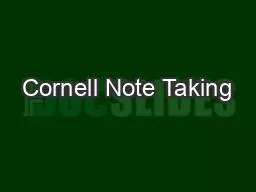

Taking effective notes is an essential part of the academic experienceEffective noteshelp students organize and process data and informationhelp students remember what is said in classcan help student ID: 859097
Download Pdf The PPT/PDF document "Cornell Note Taking" is the property of its rightful owner. Permission is granted to download and print the materials on this web site for personal, non-commercial use only, and to display it on your personal computer provided you do not modify the materials and that you retain all copyright notices contained in the materials. By downloading content from our website, you accept the terms of this agreement.
1 Cornell Note Taking Taking effecti
Cornell Note Taking Taking effective notes is an essential part of the academic experience. Effective notes: help students organize and process data and information help students remember what is said in class can help students complete assignments and prepare for assessments when outside of class Cornell note taking stimu lates critical thinking skills and helps students recall by getting them to process their notes 3 times ... writing is a great tool for learning. Cornell notes were d evelope d in 1949 at Cornell University and were d esigned in response to frustration over student test scores ... meant to be easily used a test study guide. Cornell note taking has been a dopted by most major law schools as the preferred note taking method . How to Take Cornell Notes
2 1. Read your text. 2. In the
1. Read your text. 2. In the large right hand column of your cornell note paper , take notes like you normally would using any sty le of note - taking you wish ... outline format, narrative format, symbols, short hand, etc. . 3. In the left hand column, create questions about your notes. These questions should elicit critical thinking skills and should reflect : 1) main ideas; 2) topics/ information you don’t understand or want to discuss with your teacher; 3 ) information you th ink would go good on an essay; 4 ) gaps in your not es (see example #1). 4. In addition to questions, key terms, key people and/or events, academic or content vocabulary can also be included in the left hand column (see example #2 ). 5. When finished with each page , write
3 a 2 - 3 sentence summary of your
a 2 - 3 sentence summary of your notes at the bottom of the page . EXAMPLE #1 Questions/Main Ideas: Notes: 1. What is the definition of Propaganda: Messages intended to persuade audiences to propaganda? adopt a certain opinion. 2. What are 4 common Advertisers use propaganda using 4 techniques: techniques used by advertisers? Testimonial Bandwagon Plain Folks Transfer 3. What is an example of the Testimonial Example: Michael Jordan sells Nike shoes. testimonial technique? Summary, Reflection, Analysis Advertisers use propaganda to sell products. There are 4 common propaganda techniques used by advertisers. C lass Notes/Tex
4 tbook Notes Topic: Propaganda Techn
tbook Notes Topic: Propaganda Techniques in Advertising Name: Class: Date: Period: EXAMPLE # 2 Tips for Taking Text book Notes Think about the R eading : c onsider how the parts relate to the whole; how the text relates to previous ideas create q uestions about new words/terms and/or why emphasized points are important examine what you have learned from visuals in the text look for the pattern s in elements like chapter/subsection headings, summary points, graphics Textbook Note Taking : i nclude headings, key terms and graphics take down only the important ideas ... be brief, but clear summarize all information in your own words use symbols to highlight important for re
5 view use textbook review questions t
view use textbook review questions to develop study question s Reviewing Textbook Notes : highlight main ideas fill in details for better understanding ide ntify unclear information and/or questions delete unnecessary information review note organization; add symbols or rewrite write a summary Studying with Textbook Notes : cover the right side of your notes and review and answer study questions from the left using the right side as an answer key quiz yourself out loud cover the right side with blank paper ... write out answers to the left column study questions w rite summaries of the most important material in the summary/reflection section write a quiz for o thers using notes; exchange and correct write anticipated test questions beyond those alread
6 y in the left - hand column and write a
y in the left - hand column and write answers l ook over notes frequently to keep information and questions still unanswered fresh in mind recite information from note s use notes in study groups to provide a common ground of material for reference and review rewrite notes if necessary Questions/Main Ideas: Notes: Summary, Reflection, Analysis C lass Notes/Textbook Notes Topic: Name: Class: Date: Period: Questions/Main Ideas : Notes: Summary, Reflection, Analy